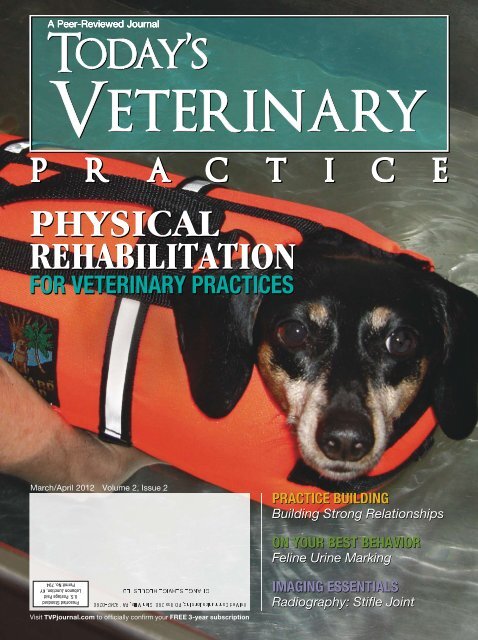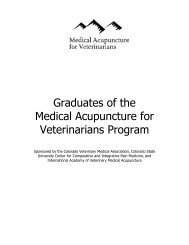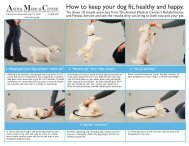Physical Physical - Tripawds Downloads
Physical Physical - Tripawds Downloads
Physical Physical - Tripawds Downloads
- No tags were found...
You also want an ePaper? Increase the reach of your titles
YUMPU automatically turns print PDFs into web optimized ePapers that Google loves.
A Peer-Reviewed Journal<strong>Physical</strong>RehabilitationfOr veterinarY PracticesMarch/April 2012 Volume 2, Issue 2Practice BuildingBuilding Strong RelationshipsOn YOur Best BehaviOrFeline Urine MarkingPresorted StandardU.S. Postage PaidLebanon Junction, KYPermit No. 794Visit TVPjournal.com to officially confirm your FREE 3-year subscriptionimaging essentialsRadiography: Stifle Joint
Today’s TechnicianPeer reviewedFelineFriendlyArticlePain Assessmentin dogs & CatsAnusha Balakrishnan, BVSc, and Elana Benasutti, CVTThe greatest evil isphysical pain.– saint augustinePain has long been recognized in humanmedicine as having a deleterious effecton several organ systems in the body. Ithas been shown to:• Amplify the body’s stress response to traumaticinjury• Cause several metabolic and endocrinederangements• Impede healing and patient recovery.DefinitionsPain in veterinary patients has been defined as anaversive sensory and emotional experience associatedwith actual or potential tissue damage. 1 Potentialcauses of pain include:• Trauma• Major or minor surgery• Acute or chronic inflammatory conditions.Pain may also be felt in the absence of any identifiablenoxious stimulus. In such cases, the pathologymay exist in the central nervous system (neuropathicpain) causing the animal to perceive painthat is inappropriately excessive for the degree ofinflammation or tissue trauma.Pain is typically classified as acute or chronic:• Acute pain is broadly defined as pain that lastsfor a short period of time and usually subsidesafter the inflammatory and healing processesare completed.• Chronic pain is a more complex phenomenon,and can last much longer than acutepain (up to lifelong).68Today’s Veterinary Practice March/April 2012
Recognition and control of acute pain in the earlystages is important, as undermanaged acute pain has ahigher likelihood of incomplete resolution, therefore,resulting in chronic pain. 2the CoMMuniCAtion GAPThe patient’s inability to speak makes the task of properpain assessment challenging: the patient cannot communicateabout:• Character of pain• Location or length of pain• Whether pain exists.The veterinary professionals responsible for patientcare must, therefore, rely upon the word of the animalowner, their own clinical observations, and the variousparameters that have been documented to assess painin patients.PAin sCAles & MAnAGeMent GuiDelinesSeveral pain scoring scales and sets of pain managementguidelines have been developed for use in veterinarypatients. They can be used for serial monitoring of painlevels in hospitalized patients, which facilitates optimalpain management for an in-clinic patient, despite differentpersonnel caring for that patient throughout its stay.Obvious limitations to this approach include the factthat these parameters are affected and altered significantlyby trauma, surgery, anesthesia, pharmacologicinterventions, and the stress of being handled by veterinarypersonnel.Today’s Technician |• Simple Descriptive Scales: Canine SimpleDescriptive Pain Scale, ivapm.evetsites.net/refId,20473/refDownload.pml (case-sensitive)• Visual Rating Scales.These types of scales allow the user to grade pain asnone, mild, moderate, or severe. While relatively easy andstraightforward to use, these systems may not be verysensitive in distinguishing subtle changes in pain levels.The Visual Analog Scale (VAS; partnersagainstpain.com/printouts/A7012AS1.pdf) has been widely used inhuman medicine and has also been evaluated in severalveterinary studies. 8-11 The scale consists of a line, mostoften 100 mm long, with 2 descriptors representingextremes of pain intensity (no pain and extreme pain)at each end. Users make a mark somewhere along theline that represents the pain intensity, and the VAS isscored by measuring the distance from the “no pain”end of the line. While it has been shown to be sensitiveand reproducible, a major shortcoming of this scoringsystem is that it relies heavily on the experience andfamiliarity of the user with VAS. 9Behavior-Based Pain AssessmentA behavior-based acute pain scoring system—theGlasgow Composite Measure Pain Scale (CMPS)—was developed at the University of Glasgow, which takesPain assessment in dogs & catsAcute & Chronic PainSome scoring systems and guidelines have been shownto be useful in assessing and quantifying chronic pain,such as pain associated with osteoarthritis in dogs andcats. These systems/guidelines often rely upon questionnairesprovided to animal owners and use easily assessablebehavioral characteristics, such as activity levelsand ability to exercise, to evaluate pain:• AAHA/AAFP Pain Management Guidelines forDogs and Cats 1 : aahanet.org/publicdocuments/painmanagementguidelines.pdf• Questionnaire to Measure the Effects of ChronicPain on Health-Related Quality of Life in Dogs 3A few systems have been developed to assess acutepostsurgical pain, which may be more relevant in ahospital setting:• Subjective and Objective Measures ofPostoperative Pain in Cats 4• Canine Acute Pain Scale 5 : ivapm.evetsites.net/refId,20468/refDownload.pml (case-sensitive)• Feline Acute Pain Scale 5 : ivapm.evetsites.net/refId,20467/refDownload.pml (case-sensitive)• Acute Postsurgical Pain in Dogs and Cats 6• Scale to Evaluate Postoperative Pain in Dogs. 7Pain GradingOther systems that have been described include:Figure 1. Glasgow Composite Measure Pain Scale–Short FormMarch/April 2012 Today’s Veterinary Practice 69
| Today’s TechnicianPAin AssessMent in DoGssome signs of pain in dogs are apparent andeasily detectable, while others are more subtle.table 1 lists the most common signs of pain indogs: 14-18table 1. signs of Pain in DogsCategoryAttitude/MentationBodyMovementfacialexpressionGuardingPostureRespiratoryPatternvocalizationClinical signs• scared, submissive appearance• Unwilling to eat or interactwith people• inability to lay down• constant trembling with/without stimulation and/orhandling• Flinching from fingertipslightly brushed over thebody• Tense facial muscles withfurrowed brows• Lips drawn back• Grimace with unfocused orfearful look in eyes• dilated pupils• ears flattened against head• Guarding or biting at apainful area• Tensing abdomen whenpalpation is attempted• Growling when approached• Back or abdominal pain:hunched up or tenseappearance• severe abdominal pain:Prayer position (standing onthe hindlimbs, with sternumand forelimbs flat on thefloor)• May move to back of cageor into corner• short, shallow breathingpattern• crying, whining, whimperinginto consideration several parameters, such as: 12,13• Demeanor• Response to people• Posture, mobility, and activity• Response to touch• Attention to painful area• Vocalization.This pain scoring system has been well validated foruse in veterinary medicine, and has been shown to bereliable and sensitive. Application of scaling models tothis score has also enabled the use of this system inclinical research and clinical trials. 13A shorter version of the CMPS, the Short Form(CMPS-SF, Figure 1, page 69), 14 was developed in 2007for the purpose of routine clinical use, with emphasison speed, ease of use, and guidance for analgesiaprovision. The CMPS-SF is comprised of 6 behavioralcategories with associated descriptive expressions:1. Vocalization (4 descriptions)2. Attention to wound (5 descriptions)3. Mobility (5 descriptions)4. Response to touch (6 descriptions)5. Demeanor (5 descriptions)6. Posture/activity (5 descriptions).Items are placed in increasing order of pain intensityand numbered accordingly. The observer choosesthat item within each category that best describes thepatient’s behavior and ranked scores are summed; themaximum pain score is 24; 20, if mobility is impossibleto assess.Figure 2. Anxious, postoperative patient.Courtesy Holly Killian, CvTsuBjeCtive PAin AssessMentPractical clinical experience is one of the most effectiveways to become adept at pain assessment. Signs of painvary greatly among individual patients, and differencesin pain expression may be subtle and difficult to evaluatewithout sufficient experience or knowledge. 1Clinical experience is also valuable because somesigns of pain must be assessed by touch (tactile versusvisual assessment). For example, tenseness of theabdomen is best assessed with gentle palpation.In the hospital setting, particularly 24-hour facilitieswhere patients may be monitored by several differentveterinarians and veterinary technicians, it becomesvital to:• Discuss pain assessment for each patient amongthe practice team• Have the same individual, as often as possible,70Today’s Veterinary Practice March/April 2012
Today’s Technician |Pain assessment in dogs & catsFigure 3. Painful, postoperative thoracotomy patient;note the facial expression with grimace and furrowedbrows. Courtesy Holly Killian, CvTFigure 4. Patient from Figure 3 resting morecomfortably after a dose of analgesics.Courtesy Holly Killian, CvTmake serial assessments of a patient’s pain toreduce the possibility of interobserver variability.• Develop a specific pain assessment protocol thatallows all personnel to use the same parametersto assess patient pain.visual Pain AssessmentPrior to Examination• The patient should be evaluated from a distanceprior to handling to avoid changes in behaviorresulting from human proximity. 15,16• While observing, the respiratory rate and patternof breathing should be noted.• Posture, facial expression, position of ears, andtenseness of body should all be observed as theymay change significantly once the caregiver interactswith the patient.Examination Room• In an examination room setting, it may be beneficialto observe and examine the patient bothwith and without the owner present. For example,animals that are frightened or suffer from separationanxiety may be easiest to examine with theowner in the room.• Pet owners should be asked about their animal’snormal behavior at home and how they havereacted to pain previously. This allows better painassessment during physical examination and hospitalstay.In the Hospital• Some hospitalized patients will let down theirguard and allow signs of pain to be observed.• However, there are many that never relax whilehospitalized, and subsequently are much moredifficult to accurately assess.• There are also animals that maintain their inherentsurvival mechanism, which causes them to hideany sign of weakness, including pain. These stoicdogs can appear deceptively relaxed and comfortable,despite being in significant pain.<strong>Physical</strong> examinationA thorough physical examination should be performedafter the initial visual examination. However, theimportance of physical examinations to assess patientpain must be balanced against the possibility of causinga patient further stress with repeated handling.• Gentle and compassionate handling of the patientduring the examination is vital, particularly ifpatient pain is anticipated.• Potentially stressful procedures, such as checkingrectal temperature, should be performed at theend of the examination, if possible.• If the source of pain is already known, the rest ofFigure 5. A patient resting comfortably in the hospitalMarch/April 2012 Today’s Veterinary Practice 71
| Today’s Technicianthe examination should be completed before assessingit; however, if the source of pain is unknown,potential causes should be determined prior tofurther examination.Physiologic ChangesPain, which causes increased stimulation of the sympatheticnervous system, results in many physiologicchanges reflected in physical examination findings.These changes include: 20• Elevated heart rate• Elevated body temperature• Elevated respiratory rate +/- increased respiratoryeffort.However, these parameters may be altered due tofactors, such as anxiety, surgery complications, or clinicalconditions (eg, hypotension). If physiologic changescontinue once pain is adequately controlled, othercauses should be considered.Tactile Pain AssessmentSeveral signs of pain can be detected by tactile manipulation.Eliciting pain through palpation of affected bodyparts may be the only way to recognize that pain exists.• Most animals will vocalize or show obvious signs ofdiscomfort when the affected area is manipulated.• Gentle yet thorough abdominal palpation can beextremely useful in detecting focal pain, particularlyin conditions, such as pancreatitis, renal paincaused by pyelonephritis or nephroliths, gastrointestinalobstructions, or urethral obstructions.• Musculoskeletal pain can be detected by a thoroughorthopedic examination, including superficial anddeep palpation of the muscle and bone, flexion,extension, and range of motion assessment, particularlyin the limbs, to identify signs of swellingor joint effusion.sPeCifiC ChAllenGes of PAinAssessMentDue to variability in each animal’s expressionof pain, pain assessment in veterinarypatients can be very challenging.Signs of pain need to be evaluatedin the context of patienthistory, physical examination,and laboratory findings.A stoic animal in whichpain is suspected but difficultto identify should stillbe treated appropriately,especially if the diseaseprocess or procedurewarrants it. Response totherapy can serve as adiagnostic tool for painassessment, especiallyif improvement in thepatient’s demeanor or posture is noted.Some signs of pain discussed earlier are subjectiveand not specific. Several other conditions can causethese signs in patients. Some of the more commonlyencountered examples include:• Elevated heart rate, temperature, blood pressure,or respiratory rate/effort: Caused by a plethoraof systemic conditions and the least specificindicators of pain in veterinary patients. 20-24• Vocalization:» Many dogs will whine or whimper quietly in arhythmic pattern when painful. Loud barking orhowling is usually related to anxiety, dysphoria,need to urinate/defecate, or need for attention.» However, rhythmic whining may also be notedin, for example, patients that need to have theirurinary bladder expressed or those sufferingfrom opioid-induced dysphoria.» It can be very difficult to differentiate dysphoriaor anxiety from true pain. Often, administeringa mild sedative will help resolve dysphoria.Switching analgesics or altering doses may alsohelp distinguish true pain from dysphoria.» Dysphoric animals usually do not respond tointeraction with caregivers; however, painfulanimals usually do.• Trembling: May be caused by pain or anxiety; inthe authors’ clinical experience, certain dog breeds,such as Yorkshire terriers or Chihuahuas, have anincreased tendency to tremble even when healthyand pain free.• Pupillary Dilation: Can have multiple etiologiesin addition to pain, including various neurologicconditions that involve cranial nerve abnormalitiesor administration of pharmacologic agents, such asopioids (in cats) or atropine and other mydriatics.suMMARyAccurate pain assessment is becominga vital prelude to appropriateand adequate pain management.Pain recognition and management,therefore, become essentialsteps toward our goal of deliveringcompassionate, humane, and scientificallysound medicine for the animalsin our care. ■CMPS = Glasgow Composite MeasurePain Scale; CMPS–SF = Glasgow CompositeMeasure Pain Scale–Short Form; vAS = visualanalog scaleReferences1. Hellyer P, rodan i, Brunt J, et al. AAHA/AAFP pain managementguidelines for dogs and cats. J Fel Med Surg 2007; 9(6):466-480.2. Matthews KA. Pain assessment and generalapproach to management. Vet Clin N Am SmallAnim Prac 2000; 30:729-755.72Today’s Veterinary Practice March/April 2012
PAin AssessMent in CAtsaccurate pain assessment in cats can be challenging. <strong>Physical</strong> examination findingsindicative of pain may include:• negative reaction when a painful area is palpated• Vocalizing• Trying to escape• Growling• scratching or biting.cats that are seriously ill or more subdued may only flinch when a tender area is touched, while othersmay be so fractious and difficult to handle that ascertaining their pain is almost impossible.Today’s Technician |Pain assessment in dogs & catsBehaviorif possible, owners should be asked about the cat’s usual behavior and attitudein the clinic/hospital setting. When a cat that historically has a mild temperament,even in the clinic, is fractious, growls, or attempts to bite when approached, it maybe an indicator of discomfort or pain (eg, urethral obstruction).When left alone, a painful cat usually curls up and remains withdrawn andquiet. Respiratory rate may increase with pain, but this may be the only obviousvisual sign, apart from lack of interest in surroundings and decreased interactivity.PosturePainful cats tend to remain confined to a small area, usually in one position. nonpainful cats have a posethat is relaxed in a subtle way in comparison to the somewhat stiff, tense posture of a painful cat.Painful cats may also have a tendency to hide, but this is nonspecific as healthy cats also tend to hide,particularly in unfamiliar hospital surroundings. some painful cats may bite at themselves and attemptto mutilate the affected area, or may run around frantically, often backing up in an apparent attempt toescape the pain, while others may lay still in response to severe pain and even purr.table 2 lists the most common signs of pain in cats. 15,16,18,22table 2. signs of Pain in CatsCategoryAttitude/MentationBody MovementGuardingPostureRespiratory PatternvocalizationClinical signs• Usually withdrawn; may become aggressive• absence of normal behaviors, such as grooming• May tremble if in extreme pain• Usually flinch when painful area is touched even lightly• often guard painful area by hissing, swatting, or biting• Remains in the same position for long periods of time• stiffly sits sternal, with head tucked under or laying flat• if curled up, may have stiff, “hunkered down” appearance• sometimes tachypneic• Meowing mournfully• Purring3. wiseman-Orr ML, Nolan AM, reid J, et al. development of aquestionnaire to measure the effects of chronic pain on health-relatedquality of life in dogs. Am J Vet Res 2004; 65(8):1077-1084.4. Cambridge AJ, Tobias KM, NewberryrC, Sarkar dK. Subjectiveand objective measures of postoperative pain in cats. JAVMA 2000;217(5):685-690.5. Hellyer Pw, Uhrig Sr, robinson NG. Canine acute pain scale andfeline acute pain scale. Colorado State University veterinary MedicalCenter, 2006.6. Hellyer Pw, Gaynor JS. Acute postsurgical pain in dogs and cats.Compend Contin Educ Pract Vet 1998; 20:140-153.7. Firth AM, Haldane SL. development of a scale to evaluatepostoperative pain in dogs. JAVMA 1999; 214:651-659.8. Jensen MP, Chen C, Brugger AM. interpretation of visual analogscale ratings and change scores: A reanalysis of two clinical trials ofpostoperative pain. J Pain 2003; 4(7):407-414.9. Holton LL, Scott eM, Nolam AM, et al. Comparison of three methodsused for assessment of pain in dogs. JAVMA 1998; 212:61-66.10. Hudson JT, Slater Mr, Taylor L, et al. Assessing repeatability andvalidity of a visual analogue scale questionnaire for use in assessingpain and lameness in dogs. Am J Vet Res 2004; 65(12):1634-1643.11. welsh eM, Gettinby G, Nolan AM. Comparison of a visual analog scaleand a numerical rating scale for assessment of lameness, using sheepas the model. Am J Vet Res 1993; 54:976-983.12. Holton L, reid J, Scott eM, et al. development of a behavior-basedscale to measure acute pain in dogs. Vet Rec 2001; 148:525-531.13. Morton MC, reid J, Scott eM, et al. Application of a scaling modelto establish and validate an interval level pain scale for assessment ofacute pain in dogs. Am J Vet Res 2005; 66:2154-2166.14. reid J, Nolan AM, Hughes JML, et al. development of the short-formGlasgow Composite Measure Pain Scale (CMPS-SF) and derivation ofan analgesic intervention score. Anim Welf 2007; 16(S):97-104.15. Sackman J. Pain management. in McCurnin dM, Bassert JM (eds):Clinical Textbook for Veterinary Technicians, 5th ed. Philadelphia: wBMarch/April 2012 Today’s Veterinary Practice 73
| Today’s TechnicianAnusha Balakrishnan, BVSc, is a firstyearresident in small animal emergencyand critical care medicine at Universityof Pennsylvania School of VeterinaryMedicine. Her special interests includesepsis, shock, and coagulopathies. Dr.Balakrishnan received her veterinarydegree from Madras Veterinary College(India), followed by a small animal rotatinginternship at University of Wisconsin–Madison School of Veterinary Medicine.Elana M. Benasutti, CVT, has been acritical care nurse in the Intensive CareUnit of the University of PennsylvaniaMatthew J. Ryan Veterinary Hospital for10 years. Prior to her current position,Ms. Benasutti was an ultrasoundtechnician in the radiology department.She recently wrote a chapter foradvanced Monitoring and Proceduresfor small animal emergency andcritical care, edited by Jamie M. Burkitt and Harold Davis.Ms. Benasutti is a graduate of Harcum Junior College in BrynMawr, Pennsylvania. In addition to small animal veterinarymedicine, she also pursues an interest in dairy farming.Saunders, 2002, p 512.16. Orskov T. Pain assessment in cats and dogs. IrishVet J 2010; 63(6):362-364.17. Brodbelt dC. Anesthesia and analgesia. in Lanedr, Cooper B (eds): Veterinary Nursing, 2nd ed.Philadelphia: elsevier Butterworth-Heinemann,1999, p 637.18. Hansen B. Pain and pain management. in Fennerwr: Quick Reference to Veterinary Medicine, 3rded. Baltimore: Lippincott williams and wilkins,2000, pp 45-47.19. Mathews KA. Non-steroidal anti-inflammatoryanalgesics for acute pain management in dogsand cats. Vet Comp Orthop Traumatol 1997;10:122-129.20. Holton LL, Scott eM, Nolan AM, et al. relationshipbetween physiologic factors and clinical pain indogs scored using a numerical rating scale. JSmall Anim Prac 2008; 39(10):469-474.21. Conzemius MG, Brockman dJ, King LG, et al.Analgesia in dogs after intercostal thoracotomy: Aclinical trial comparing intravenousbuprenorphineand intrapleuralbupivicaine. Vet Surg 1994;23:291-298.22. Smith Jd, Allen Sw, Quandt Je, et al. indicatorsof postoperative pain in cats and correlation withclinical criteria. Am J Vet Res 1996; 57:1674-1678.23. Sammarco JL, Conzemius MG, Perkowski SZ,et al. Postoperativeanalgesia for stifle surgery: Acomparison of intra-articularbupivicaine, morphineor saline. Vet Surg 1996; 25:59-69.24. Conzemius MG, Hill CM, Sammarco JL, et al.Correlation between subjective and objectivemeasures used to determine severity ofpostoperative pain in dogs. JAVMA 1997;210:1619-1622.of Excellence10,183 DAYS.145,850 PRODUCTS.ENDLESS POSSIBILITIES.For over 25 years the TriStar Metals family has stoodbehind our products, our customer service and you.We call it the TriStar Difference. See our full line ofveterinary equipment at tristarvet.com.MT-50SLFollow us for exclusive offers!www.facebook.com/TriStarVet877.459.782774Today’s Veterinary Practice March/April 2012






